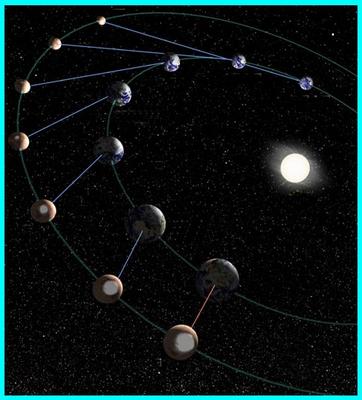
Eyes to the sky for the Mars spectacular
The Middle East Times
10-24-05
PARIS -- The last time Mars swung so close to Earth, Hindu seers foretold of war, European astrologers predicted love and Germany reported a rash in UFO sightings.The Middle East Times
10-24-05
Thus is the spell cast by planetary alignment, so extreme predictions and odd events seem entirely possible this week as Mars and Earth edge together once more.
On Sunday, October 30, the Red Planet will be 69.4 million kilometers (43.1 million miles) from Earth - a distance that in galactic terms is less than wafer-thin and will not be equaled until 2018.
Sky watchers are rubbing their hands at the opportunity.
In the run-up to Sunday, but also for much of November, Mars will appear as a big orangey-yellow "star" in the east, an object so bright that it should be visible in almost any conditions of light pollution, says the US publication Sky & Telescope.
Weather permitting - on Earth and also on Mars, where there are some worrying signs of an impending dust storm - anyone with a modest telescope should be able to pick out some of the features that make Mars so special.
According to the French magazine Ciel et Espace, anyone who invests in a small 60-millimeter (two-inch) -diameter telescope, priced in many countries at around €150 ($180), should be easily able to spot Syrtis Major, Mars' most recognizable characteristic.
This vast region of cratered plateaus appears as a dark, roughly triangular-shaped tongue whose point heads toward Mars' North Pole.
They should also be able to make out Helas, a vast impact crater that is often covered by whitish mist and is sometimes mistaken for Mars' southern polar icecap.
Invest a couple of thousand euros or more to get a telescope with a diameter of 200 millimeters or more - or go to your nearest observatory or visit an astronomy Website - and some really hunky stuff comes into view.
For size, nothing beats Mons Olympus, 26,000 meters (84,500 feet) high - the biggest volcano in the Solar System. And Arizona's Grand Canyon would fit snugly inside Valles Marineris - seven kilometers (four miles) deep and 200 kilometers across.
Mars' southern pole, seasonally shrunk by summer heat, will appear as a brilliant white dot. And with luck, one night you might bag Mars' tiny moons, Phobos and Deimos, which once were asteroids until they were captured by the Martian gravity.
On August 27, 2003, Earth and Mars were a mere 55.76 million kilometers apart, the closest in almost 60,000 years.
This time, the planets are slight farther apart, but the viewing prospects are better than in 2003, says the Institute of Celestial Mechanics at the Paris Observatory.
This is because, in 2003, Mars' course barely took it above the horizon for viewers in Earth's northern hemisphere, which meant that the image was distorted by light passing through the atmosphere.
Earth, the third planet from the Sun, takes 365 and a quarter days to go around its star. Mars, the fourth planet, takes 687 Earth Days.
That means that they come close every 26 months or so. But both planets take a slightly elliptical path around the Sun, and this factor determines precisely how close the flyby will be.
The next time the planets will be closer than in 2003 will be in 2287.
More . . .
Home
No comments :
Post a Comment
Dear Reader/Contributor,
Your input is greatly appreciated, and coveted; however, blatant mis-use of this site's bandwidth will not be tolerated (e.g., SPAM, non-related links, etc).
Additionally, healthy debate is invited; however, ad hominem and or vitriolic attacks will not be published, nor will "anonymous" criticisms. Please keep your arguments/comments to the issues and subject matter of this article and present them with civility and proper decorum. -FW